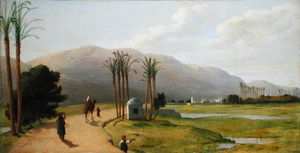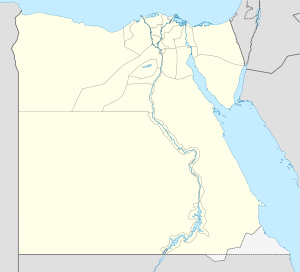Asyut
- Lycopolis and Lykopolis redirect here; for the ancient city bearing those names located in the delta of the Nile, see Lycopolis (Delta).
| Asyut | |
|---|---|
 |
|
 Asyut
|
|
| Coordinates: | |
| Country | |
| Governorate | Asyut Governorate |
| Time zone | EST (UTC+2) |
| - Summer (DST) | +3 (UTC) |
Asyut (Arabic: أسيوط), is the capital of the modern Asyut Governorate, Egypt; there is an ancient city nearby. The modern city is located at: , while the ancient city is located at: .
Contents |
Etymology
| Asyut in hieroglyphs |
|---|
The name of the city is derived from early Egyptian Zawty (Z3JW.TJ) (late Egyptian, Səyáwt) into the Coptic Syowt ⲥⲓⲟⲟⲩⲧ. In Graeco-Roman Egypt, it was called Lycopolis or Lykopolis (Greek: Λυκόπολις, "ἡ Λύκων πόλις"), [1] Lycon, [2] or Lyco [3].
Ancient Asyut
Around 3100 BC ancient Asyut was the capital of the Thirteenth Nome of Upper Egypt (Lycopolites Nome), seated on the western bank of the Nile. The two most prominent gods of pre-Christian Asyut were Anubis and Wepwawet, both funerary deities.
During the First Intermediate Period, the rulers of "Zawty"; Khety I, Itefibi, and Khety II were supporters of the Herakleopolitan kings, of whose domain the Nome formed the southern limits. The conflict between this Nome and the southern Nomes under the rule of the Eleventh dynasty ended with the victory of Thebes and the decline of Asyut's importance.
The shield of a king named Recamai, who reigned in Upper Egypt (probably during the "shepherd dynasty" in the "Lower Country"), has been discovered in Asyut [4]. Lycopolis has no remarkable ruins, but in the excavated chambers of the adjacent rocks are found mummies of wolves, confirming the origin of its name, as well as a tradition preserved by Diodorus Siculus [5], to the effect that an Aethiopian army, invading Egypt, was repelled beyond the city of Elephantine by herds of wolves. Osiris was worshipped under the symbol of a wolf at Lycopolis. He having, according to a myth, come "from the shades" under that form, to aid Isis and Horus in their combat with Typhon [6]. Other Ancient Egyptian monuments discovered in Asyut include; the Asyut necropolis (west of the modern city), tombs which date to dynasties Nine, Ten and Twelve, and Ramessid tombs of Siese and Amenhotep.
In Graeco-Roman times, there was a distinct dialect of Coptic spoken in Asyut, known as "Lycopolitan", after the Greek name for the city. Lesser-used names for this dialect are "Sub-Akhmimic" and "Assiutic".
Modern Asyut
Today, the city of Asyut has almost 400,000 inhabitants.[7]It is the Egyptian city with the highest Coptic Christian concentration. It is also home to the University of Asyut, one of the largest universities in Egypt, Assiut Barrage, and to the Lillian Trasher Orphanage. The Virgin Mary is reported to have appeared in Asyut on 17 August 2000. This apparition is recognized as official by the Coptic Orthodox Church.
Climate
The city of Asyut is located tightly between two ranges of about 600m-mountains on both western and eastern sides. And interestingly it falls in mid Egypt, away from the Mediterranean Sea and the Red Sea. Hence, this conditions gives the city, nearby towns and villages a typical properties of continental climate. Meaning that the city has harsh and chilly cold winter weather, and very hot but non-humid summers. During summer times, the temperature could reach 40C and exceed it to 42C. Yet, in winter Asyut gets sub-zero temperatures during nights and frost can be formed easily. While hail or snow are extremely rare cause of the low averages of the city's rain precipitation.
People from Asyut
- Coluthus (5th century) Greek poet
- Gamal Abdel Nasser - The second Egyptian president.
- Shenouda III, current Pope of the Coptic Orthodox Church.
- Ahmed Lutfi el-Sayed - Egyptian nationalist.
- Meletius of Lycopolis, founder of the Meletians[8]
- al-Suyuti a Sunni scholar who died in the year 1505
Twinnings
 Iaşi, Romania
Iaşi, Romania
References
- This article incorporates text from the public domain Dictionary of Greek and Roman Geography by William Smith (1856).
- ↑ Ptol. iv. 5. § 63; Steph. B. s. v.; Strabo xvii. p. 813)
- ↑ (Plin. v. 9. s. 11)
- ↑ (Itin. Anton. p. 157)
- ↑ (Rosellini, Mon. Civ. i. 81.)
- ↑ (ii. 88; comp. Aelian. Hist. An. x. 28)
- ↑ (Champollion, Descript. de l'Egypte, vol. i. p. 276; Jollois, Egypte, vol. ii. ch. 13.)
- ↑ Egypt [ City Population: Cities, Towns, Countries & Provinces, Statistics & Maps ]
- ↑
 "Lycopolis". Catholic Encyclopedia. New York: Robert Appleton Company. 1913.
"Lycopolis". Catholic Encyclopedia. New York: Robert Appleton Company. 1913.
![]() This article incorporates text from a publication now in the public domain: Herbermann, Charles, ed (1913). Catholic Encyclopedia. Robert Appleton Company.
This article incorporates text from a publication now in the public domain: Herbermann, Charles, ed (1913). Catholic Encyclopedia. Robert Appleton Company.
Bibliography
- Loprieno, Antonio: Ancient Egyptian: A Linguistic Introduction, Oxford U Press 1996. ISBN 0-521-44849-2
- Baines & Malek Cultural Atlas of Ancient Egypt, 2000. ISBN 0-8160-4036-2
- Kahl, Jochem: Ancient Asyut: The first Synthesis after Three Hundred Years of Research. The Asyut Project vol. I. Wiesbaden 2008. ISBN 978-3447056663
External links
 Media related to Asyut at Wikimedia Commons
Media related to Asyut at Wikimedia Commons
|
|||||
|
|||||
|
|||||